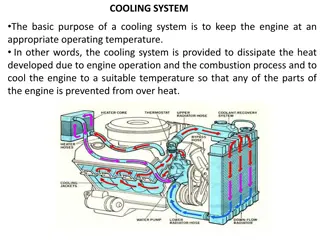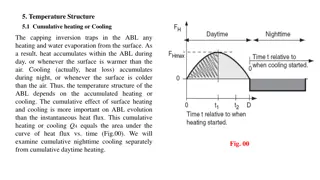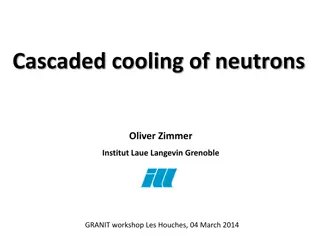Study on Heating and Cooling Degree Days Analysis in Climate Data
This study focuses on analyzing Heating Degree Days (HDD) and Cooling Degree Days (CDD) based on recent climate data and program participation records. It aims to develop utility-specific HDD and CDD values, with considerations for inland and coastal regions. Tasks include weather data collection, revision of values, and presenting study results and recommendations.
Download Presentation

Please find below an Image/Link to download the presentation.
The content on the website is provided AS IS for your information and personal use only. It may not be sold, licensed, or shared on other websites without obtaining consent from the author.If you encounter any issues during the download, it is possible that the publisher has removed the file from their server.
You are allowed to download the files provided on this website for personal or commercial use, subject to the condition that they are used lawfully. All files are the property of their respective owners.
The content on the website is provided AS IS for your information and personal use only. It may not be sold, licensed, or shared on other websites without obtaining consent from the author.
E N D
Presentation Transcript
CT EEB X1931-7 HDD/CDD UPDATE STUDY SAROJ KARKI, ERS DECEMBER 16TH, 2020
2 AGENDA Study Background Study Objectives Detailed Tasks Schedule and Budget
STUDY BACKGROUND HDD Heating Degree Days CDD Cooling Degree Days NOAA National Oceanic and Atmospheric Administration TRM Technical Reference Manual TMY Typical Meteorological Year Coastal/inland differentiation for HDD/CDD R91 study recommendation Our analysis of TMY data shows that inland HDDs are 12% greater than coastal; inland CDDs are 9% greater than coastal Estimate that approximately 20% of residential program participation is classified as coastal Other TRMs offer varying DD values by geography: NY, Mid-Atlantic TRMs Secondary observation: Current PSD values consider NOAA weather, 1979-2008. Other jurisdictions are updating typical weather to reflect recent climate changes. Measures in the PSD that use HDD/CDD values: Heat pump (to calculate equivalent full load hours) Package terminal heat pump (to calculate equivalent full load hours) Insulate attic openings Wall insulation Ceiling insulation Floor insulation 3
STUDY OBJECTIVES The objectives of this study are to: Develop utility-specific HDD and CDD values based on the most recent climate data and recent program participation records. Note: we will give special consideration in the calculation of HDDs to the UI gas entities that are not coastal. Alternative 1: Develop a single statewide set of weighted HDD and CDD values. Alternative 2: Develop separate HDD and CDD values for inland and coastal regions. 4
DETAILED TASKS Task 1: Weather Data Collection and Revision of HDD and CDD values Gather 2005-present weather data for NOAA s 10 weather stations in CT. Gather recent participation data for weatherization measures offered under HES and HES-IE programs Leverage existing data from x1939 data request. Allocate measure participation counts to each of the 10 weather stations by proximity. By weighting the weather data by count by station for each utilities, develop utility-specific HDD and CDD values. Develop alternative sets of HDD/CDD values: a single statewide set and separate inland and coastal values. Task 2: Final Report and Presentation Deliver utility-specific HDD/CDD values Alternative 1: Develop a single statewide set of weighted values. Alternative 2: Develop separate inland and coastal values. Develop a draft and final memo report summarizing study results and updated values. Present study results and recommendations via a teleconference. 5
6 STUDY OBJECTIVESAND OUTCOMES Objective Method Outcomes Develop utility- specific HDD and CDD values. A set of revised HDD and CDD values for Eversource A set of revised HDD and CDD values for UI Gather historical hourly climate data (2005-present) for NOAA s ten weather stations across Connecticut. For each program administrator (Eversource and UI), allocate participation counts of applicable measures to each of the 10 weather stations by proximity. By weighting the CT weather data by count by station, calculate statewide HDD and CDD values for Eversource and UI. Alternative 1: Develop a single statewide set of HDD and CDD values. Separate HDD and CDD values for inland and coastal regions. By weighting the CT weather data by count by station, calculate statewide inland and coastal HDD and CDD values. Alternative 2: Develop HDD and CDD values for inland coastal regions. A single statewide set of HDD and CDD values. By weighting the CT weather data by count by station, calculate a single set of statewide weighted HDD and CDD values. Note: The HDD and CDD values developed under this study will be calculated assuming a residential balance temperature of 65 F. The values will not be applicable to commercial buildings that may warrant a different balance temperature.
SCHEDULEANDBUDGET December 2020: Study kickoff January 2021: Literature review February 2021 March 2021: Research synthesis April 2021: Final report and presentation Reports finalized for June PSD update Estimated Budget $9.9k Task Literature Review Analysis Reporting and Presentation Total Cost $1,400 $7,300 $1,200 $9,900 7
8 THANK YOU
CONTACT US Saroj Karki, Project Engineer II skarki@ers-inc.com 978-521-6233 www.ers-inc.com ERS is an energy and engineering consulting firm providing services in energy efficiency customer engagement, implementation, evaluation, both pre- and post-installation M&V, custom feasibility studies, and distributed and renewable generation assessment.























